AUGUST 14, 2007
Visit www.birdsasart.com
HOW I CARRY MY GEAR IN THE FIELD/THE XTRAHAND VEST
ZEGRAHM'S WILD BRITAIN CRUISE OPENINGS
ROBERT AMORUSO'S PPIWs
FORT DESOTO REPORT
MORE ON US CUSTOMS
LEARNING TO WRITE...
BIRDS AS ART KUDOS
NYC CITY SEMINAR NEWS
IPT UPDATES
Contact us by phone at 863-692-0906 (Eastern Time Zone) or by e-mail at birdsasart@att.net or birdsasart@verizon.net. The att e-mail address is best from overseas.
We gladly accept credit card orders by phone 8am till 9pm Eastern Time (8 am till 3pm Fridays).
You can use the PayPal links on the web site to order anything. Just type in the item(s) and the amount. If using your own PayPal account, please send to either of the e-mail addresses above.
Note: maximize this e-mail for best formatting.
Photographic theme: A collection of recent images...
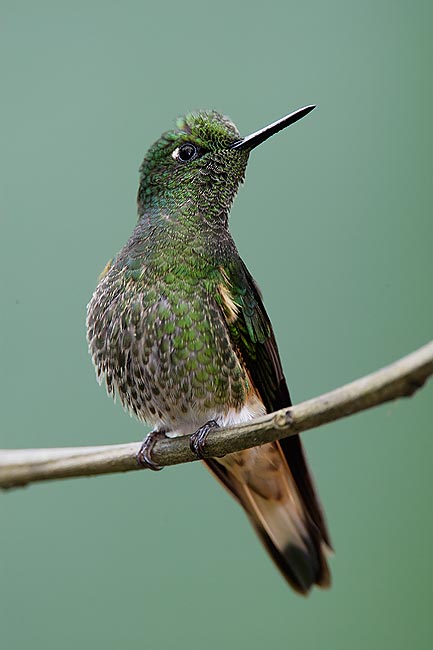
Buff-tailed Coronet, Tandayapa, Ecuador
Image Copyright 2007: Arthur Morris/BIRDS AS ART
Canon 500mm f/4L IS lens with the 1.4X II TC and a 25 mm Extension Tube with the EOS-1D Mark III. ISO 1000. Evaluative metering at zero: 1/80 sec. at f/7.1. Flash at zero.
On our layover day in Quito, several of us had arranged a bus trip to the cloud forest. As you can see by checking the exposure data, it was dark on the porch... Having a camera like the MIII that is able to produce virtually noise-free images at high ISO settings is a huge advantage in the tropics. Here it allowed me to use just a bit of extra depth-of-field. In low light I learned last year to use lots of flash on the hummingbirds.
HOW I CARRY MY GEAR IN THE FIELD/THE XTRAHAND VEST
I received an e-mail recently asking how I carry my gear in the field. Initially I responded by saying that I had covered the topic thoroughly in the Practicalities chapter in the new CD book, "The Art of Bird Photography II" (916 pages, 900 photographs: http://www.birdsasart.com/ABPII.htm). After giving it some thought, I realized that I have been doing a few things differently since the book was finished. As has been the case for more than a decade, my custom-designed Magnum Xtrahand Vest created by Vested Interest (www.vestedinterest.com) is the foundation of my system; I would be dead in the water without it. There is lots of great info on my customized vest here: http://www.birdsasart.com/bn61.htm. (Note: Xtrahand vests are custom-fitted and built to your specifications; you get John Storrie on the phone and measure yourself!) With it becoming more and more difficult to travel by air each year, my vest is an important safety net when it comes to battling the carry-on police. (See the details in ABP II.)
For me, the choice of a good vest instead of a backpack was, is, and always will be an easy one. In order to get at anything in a backpack, you first need to take it off. With a good vest, your stuff is pretty much immediately accessible. And weight distribution with an Xtrahand vest is superb. Several folks on the Galapagos trip picked up my fully loaded vest with two hands and were amazed at how heavy it was. Then they put the vest on and were amazed at how light it felt! One of the keys to surviving a heavy vest (no matter how good the weight distribution) is to remove the vest and put it on the ground when you will photographing in the same spot for more than a few minutes!
For too many decades, I rested my tripod-mounted super-telephoto lens on my right shoulder. I began having problems with that shoulder about five or six years ago. At times I have tried switching the lens to my left shoulder but oh it feels so much more comfortable on the right... I have been re-habbing my right shoulder almost constantly (but never do my exercises as regularly as I should). I have been doing a few new things to ease the strain. When I know that I will be walking for a while before encountering any likely subjects I take the rig off of the tripod and place the heavy duty lens strap on either shoulder while carrying the tripod with the hand on the opposite side. And additionally, when carrying the tripod-mounted rig, I make a concerted effort to switch shoulders every hundred yards or so.
Switching from the Gitzo Carbon Fiber 1325 to the Gitzo 3530 LSV saves me one pound. And using the Mongoose M-3.5 saves me another two pounds.
When conditions for flight photography are good, I hang an intermediate telephoto lens on one shoulder photography via the camera body strap. If flight photography does not look promising, I may or may not carry one or two of those lenses in my vest. On all field walks, I place the 1.4X II and the 2X II teleconverters (stacked together) in the large left-hand pocket of my vest, and the 24-105mm IS L zoom lens (inside a watch cap) in the right. If it is cloudy or if I will be photographing in the pre-dawn or after sunset I pack the fish-eye lens (also in a watch cap) either in the large right-hand pocket or in the rear pouch. (When it is sunny my shadow almost always appears in images created with the fish-eye...)
That about does it...
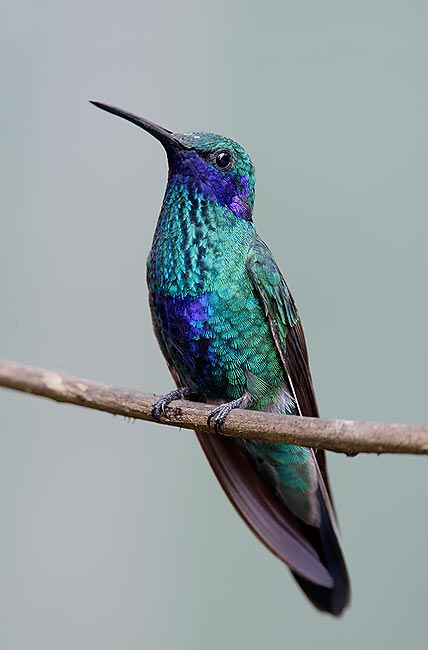
Sparkling Violet-ear, Tandayapa, Ecuador
Image Copyright 2007: Arthur Morris/BIRDS AS ART
Canon 500mm f/4L IS lens with the 1.4X II TC and a 25 mm Extension Tube with the EOS-1D Mark III. ISO 1000. Evaluative metering +1/3 stop: 1/80 sec. at f/7.1. Flash at zero.
The 500 IS with the 1.4X and a single 25mm tube is deadly with the Mark III for small birds. This bird sat for a few seconds. I created about 8 similar images; a perfect head angle and superb sharpness made this the best of the lot.
ZEGRAHM'S WILD BRITAIN CRUISE OPENINGS
With
one couple cancelling, there are now two openings on the May
28--
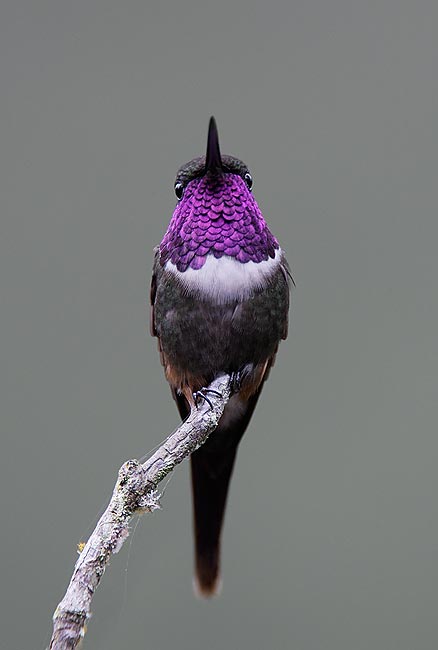
Purple-throated Woodstar, adult male, Alambi Lodge, Tandayapa, Ecuador
Image Copyright 2007: Arthur Morris/BIRDS AS ART
Canon 500mm f/4L IS lens with the 1.4X II TC and a 37 mm of extension with the EOS-1D Mark III. ISO 1000. Evaluative metering at zero: 1/200 sec. at f/6.3. Flash at zero.
For the tiniest hummers, I add a 12mm tube to the mix. There is a different mix of species at Alambi, just down the hill from Tandayapa.
ROBERT AMORUSO’S WORKSHOPS
Robert Amoruso, award winning photographer, long time student, and BAA Posse member & IPT co-leader offers BAA-approved private and small group instruction as follows:
Personalized Photographic Instructional Workshops (PPIWs)
Blue Heron
Wetlands,
PPIWs are designed for photographers of all experience levels but are especially popular with beginners. Workshop size is strictly limited to no more than four persons. Morning sessions begin pre-dawn and run 3 to 4 hours. Afternoon sessions start 3 to 4 hours before sunset and wrap up soon after that. Post processing and workflow instruction is included on the full day workshops. A five image post-workshop critique is included with all sessions. Visits to various locations aboard Robert's 17’ SeaRay open-bow boat are optional.
For rates and terms, click here: http://www.wildscapeimages.com/, click on “Instruction,” and then scroll down.
To learn more about Robert, click here: http://www.wildscapeimages.com/.
Frigatebird/DeSoto PPIWs: Magnificent Frigatebirds in flight (by boat) in the morning, Fort Desoto in the afternoon. For rates, additional details and images from previous trips, please visit: www.wildscapeimages.biz.
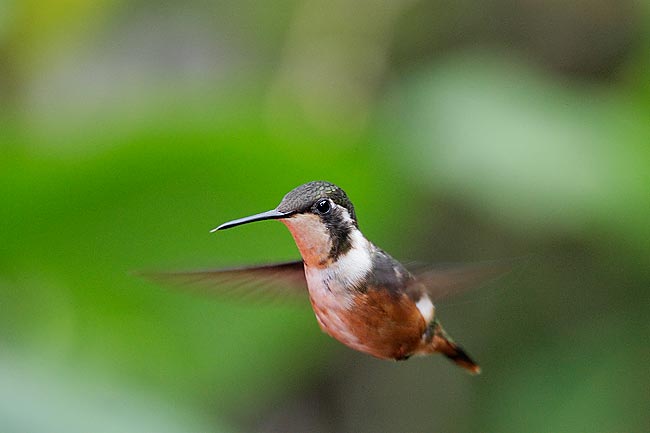
Purple-throated Woodstar, adult female, Alambi Lodge, Tandayapa, Ecuador
Image Copyright 2007: Arthur Morris/BIRDS AS ART
Canon 70-200mm f/4 L IS lens with the 1.4X TC (handheld at 280mm) with the EOS-1D Mark III. ISO 3200. Evaluative metering +1/3 stop: 1/500 sec. at f/5.6. Flash at -1 stop.
I pretty much amazed myself with the results here. Handheld hummer flight photography at ISO 3200. With the MIII it's a whole new world...
FOR DESOTO REPORT
I visited Fort DeSoto on the early mornings of August 3-4. I am happy to report that there are lots of birds present. There are several hundred shorebirds including lots of faded, molting adult Western Sandpipers, Short-billed Dowitchers, and Sanderlings as well as a few Marbled Godwits. In addition there are Black-bellied, Semipalmated, Wilson's, Piping, and Snowy Plovers. There are juvenile Royal and Sandwich Terns, many being fed by the adults plus a smattering of Least and Forster's Terns. There was a white-phase Reddish Egret on Saturday morning and a very cooperative dark phase Reddish there on both days; the dark morph just could not stop fishing. This gave me lots of time to compare various Mark III AF settings. (I now own three of them; I am taking two to AK and NYC and leaving my 1Ds MII home...)
To learn about our Fort DeSoto/Sarasota Site Guide, click here: http://birdsasart.com/siteguides.htm#the%20Fort%20DeSoto/Sarasota%20Site-Guide
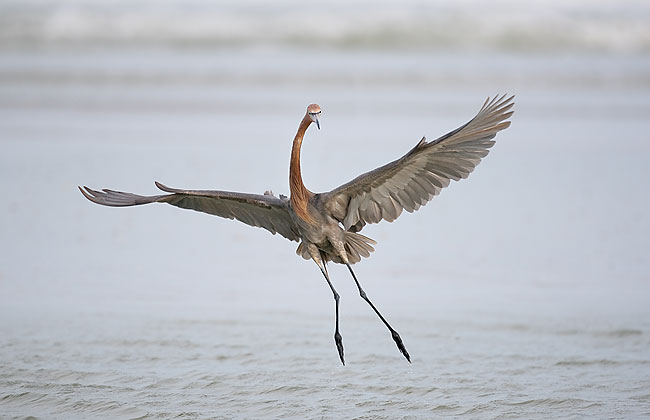
Reddish Egret, dark morph, ballet spread, Fort DeSoto Park, St. Petersburg, FL
Image Copyright 2007: Arthur Morris/BIRDS AS ART
Canon 500mm f/4 L IS lens with the EOS-1D Mark III. ISO 400. Evaluative metering +1 1/3 stops: 1/2500 sec. at f/4.
It was overcast on the first morning when I stuck with 45 point AF. Many of the images were unsharp on the eyes due to the low contrast. The head and eyes of the next image in the sequence were much sharper than the head and eyes in this image so I used Robert O'Toole's Quick Mask tricks to put a sharp head on the sharp body. As always, if it pleases you to call this a photo illustration, be my guest. You can learn more about Robert O'Toole's APTATS PDF here: http://www.birdsasart.com/aptats.htm
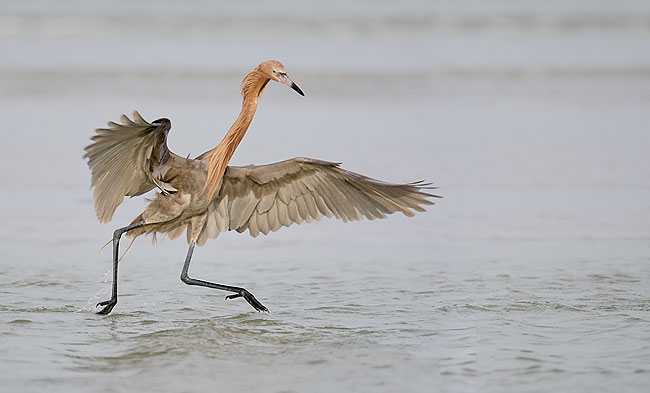
Reddish Egret, dancing over water, Fort DeSoto Park, St. Petersburg, FL
Image Copyright 2007: Arthur Morris/BIRDS AS ART
Canon 500mm f/4 L IS lens with the EOS-1D Mark III. ISO 400. Evaluative metering +1 1/3 stops: 1/1250 sec. at f/5.6.
45-point AF again. In the original, this bird was on the right side of the frame. I expanded canvas, Quick-Masked the water behind the bird, flopped it, and moved it into position. A bit of work with the Eraser Tool (as described in APTATS) and with the Patch Tool (much improved in CS3) got rid of a few repeating patterns. You can learn the basics of using the Patch Tool (and our complete digital workflow as well) in Digital Basics: http://www.birdsasart.com/digitalbasics.htm
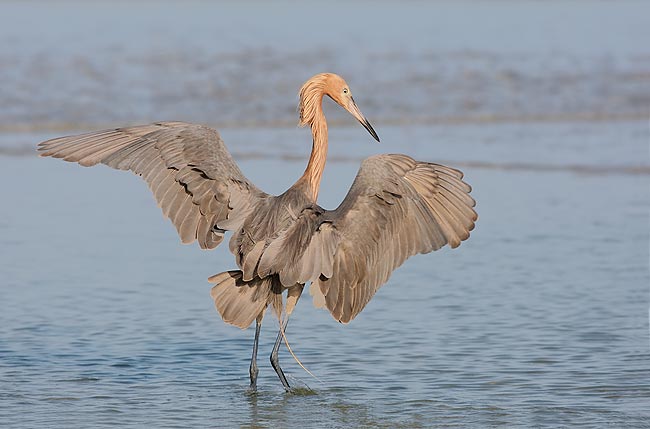
Reddish Egret, rear view, Fort DeSoto Park, St. Petersburg, FL
Image Copyright 2007: Arthur Morris/BIRDS AS ART
Canon 400mm f/5.6 L lens (handheld) with the EOS-1D Mark III. ISO 400. Evaluative metering +1 stop: 1/1600 sec. at f/7.1.
Here is one for the purists... Central sensor only. With the sun stronger on day 2 I switched gears and relied on the handheld 400 f/5.6 so that I could maintain a proper sun angle more easily. (It is easier to move when hand-holding an intermediate telephoto lens as compared to using a tripod-mounted super-telephoto...) Interestingly enough, James Shadle was photographing right along side of me. I asked him what manual exposure he had set. He responded, "1/1600 at f/7.1. I laughed and he knew why. I asked him what exposure compensation that was and he said "-2/3 stop." Two different photographers, two different systems, totally different metering systems, and each came up with a prefect exposure... Great minds think alike <smile>
.....
With fall fast approaching, first time visitors who will not be attending an IPT should consider our Bosque Del Apache Site Guide. BAA Site Guides are designed to be the next best thing to attending an IPT; when you arrive at the location you know where the birds will be, when to be at the various locations, and where to be with varying tidal, wind, and light conditions. To order your Bosque site guide click here: http://birdsasart.com/siteguides.htm#BOSQUE%20SITE%20GUIDE%20NOW%20AVAILABLE!
MORE ON US CUSTOMS
Ken Shelton wrote with a great link and a great suggestion:
You can find a list of the 300-odd Customs offices here: http://www.cbp.gov/xp/cgov/toolbox/ports/. Folks should probably look for offices at small airports and ports rather than deal with the office at, say, JFK on a busy day."
The offices are listed separately by state making it easy to find a local office. In addition there is lots of related info including phone numbers and customer service contact info. Thanks Ken!
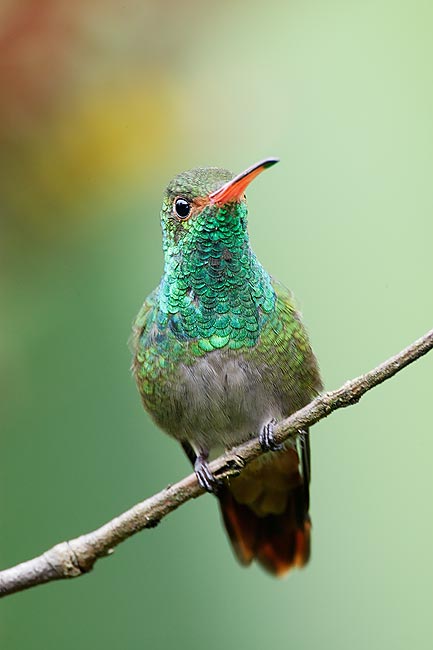
Rufous-tailed Hummingbird, Alambi Lodge, Tandayapa, Ecuador
Image Copyright 2007: Arthur Morris/BIRDS AS ART
Canon 500mm f/4L IS lens with the 2 X II TC and a 12mm Extension Tube with the EOS-1D Mark III. ISO 1000. Evaluative metering +1/3 stop: 1/50 sec. at f/10. Flash at zero.
When working at shutter speeds below 1/60 sec., flash really helps maintain sharpness...
LEARNING TO WRITE
For folks wanting to sell their images learning to write well can be vitally important. Why knock yourself out trying to sell one image to fit someone else's article when you can sell five or six images at a time and be paid for the article to boot?
Many might find this e-mail correspondence with subscriber Johnny Boyd interesting and informative.
JB: How did you learn to write about photography?
AM: By writing and trying to keep it simple. Writing is a process; by reading what I write over and over and making it better and better, simpler and simpler, cleaner and cleaner, clearer and clearer. Then I have a friend or two read it and comment on it before it is published. Above all else I strive for clarity. Because I read so much when I was a kid, I usually have no problem with clarity and usually have no problem with sentence structure and grammar. Early on, my friend Johann Schumacher, advised that I write as I speak, to try to be myself. He advised that when writing, it is generally best to use only words that I normally use in conversation. Then Julie Ridl, an editor at Birder’s World encouraged me to spice up my writing by including lots of short first-person anecdotes to spice up my how-to writing. As I progressed, Mary Beacom Bowers, former editor of Bird Watcher’s Digest and Mary Katherine Parks, of Birder’s World, were both very supportive and helped me continue to improve.
The single biggest error that I see with beginning writers is the need to hang onto every word that they have written. If a word or words or a phrase can be deleted without changing the meaning of a sentence then the word, the words, or the phrase must be deleted...
JB: Could you give me a recommendation on any books that I could read that would help me out?
The very best would be "On Writing Well" by William K. Zinsser. After that you can add "The Elements of Style" (fourth edition/paperback) by William Strunk and E. B. White.
Good luck with your writing! And later and love, artie
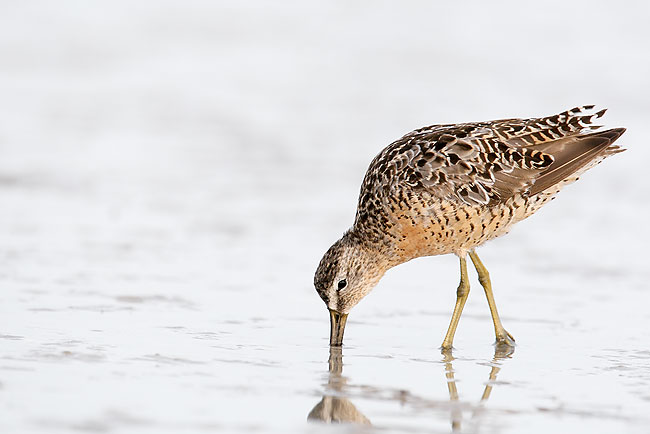
Short-billed Dowitcher, faded, molting adult foraging, Fort DeSoto Park, St. Petersburg, FL
Image Copyright 2007: Arthur Morris/BIRDS AS ART
Canon 500mm f/5.6 L lens with the 1.4X II TC and the EOS-1D Mark III. ISO 100. Evaluative metering +1 stop: 1/500 sec. at f/8.
I created many images of the feeding dowitchers. Most were unsharp due to subject movement... Adult shorebird migration is actually past its peak in most sections of the US but the young birds will begin arriving in less than a week. In the eastern US the peak of juvenile shorebird migration occurs some time during the last two weeks of August. To learn more about shorebird migration, and to learn to age and identify the regularly occurring North American shorebird species, check out my "Shorebirds; Beautiful Beachcombers" here: http://birdsasart.com/books.html#SHOREBIRDS
BIRDS AS ART KUDOS
An e-mail from Alan Fearn;
Hi Artie, Many thanks for Digital Basics! My images, especially the J-PEGs, have never looked so good. I had never used Photoshop as it should be used until now, and my web site looks fantastic thanks to you and to Digital Basics! Alan (You can learn more about the Digital Basics PDF here: http://www.birdsasart.com/digitalbasics.htm.)
By e-mail from Phillip Berryhill:
Hey Artie--The Mark III User's Guide is fantastic. I hope that you sell thousands of them. Phillip.
You can learn more about the MIII UG here: http://www.birdsasart.com/MARK%20III%20USER%20GUIDE.htm
Accomplished Photographer Wayne Nicholas (http://www.nicholasnaturephoto.com/About.htm) wrote this review of ABP II.
A Review: The Art of Bird Photography II (on CD only):
Having read Art Morris’s original publication, The Art of Bird Photography, I anticipated the release of The Art of Bird Photography II. To get the most of this CD-ROM ‘book’, I agree with Artie on his suggestion to begin by first reading the original The Art of Bird Photography before starting on this advanced how-to guide as the CD book builds on the basic fundamentals taught in the first work and doesn’t revisit them unless absolutely necessary.
The CD book is more than just a collection of inspiring images and technical talk; the discussion of various photographic equipment, techniques, tricks, and tips provide the photographer willing to try them with a vast array of weapons for their photographic arsenal. While The Art of Bird Photography gave us the basic tools we needed to understand exposure, composition, and our subjects, ABP II helps the reader to take their craft to the next level with in-depth discussions on advanced composition and a simplified explanation of both exposure and flash. The discussion of digital photography and editing techniques will take the voodoo out of these sometimes intimidating topics. You’ll find the Photoshop Gallery quite interesting as it demonstrates what can become of some of those images you’re not quite so sure of. There’s even anecdotal advice on what to consider when planning to go from home to your destination whether that be your back yard or another continent. Lastly, there is a new set of great photographic hotspots. I could go on and on about the usefulness of this text, but it will be more enjoyable if you take the time to read it for yourself.
You can learn more about ABP II (or purchase a copy) here: http://www.birdsasart.com/ABPII.htm
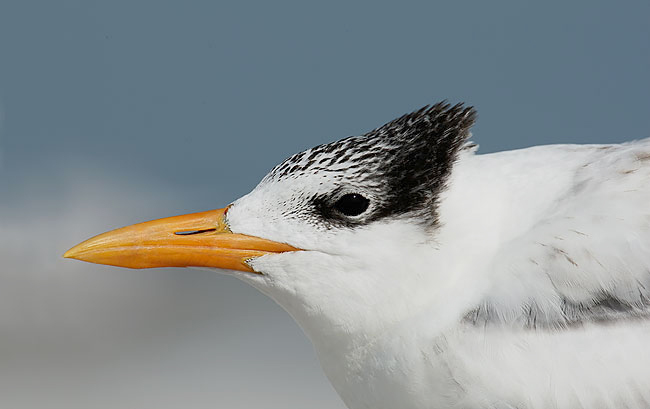
Royal Tern, juvenal plumage, Fort DeSoto Park, St. Petersburg, FL
Image Copyright 2007: Arthur Morris/BIRDS AS ART
Canon 500mm f/4 L IS lens with the 2X II TC and the EOS-1D Mark III. ISO 250. Evaluative metering +1/3 stop: 1/500 sec. at f/13.
With the distant sky as background and lots of light I was able to stop down quite a bit for extra depth-of-field without having to worry about bringing up any background detail.
NYC SEMINAR NEWS
With less than two weeks to go, we are approaching critical mass. We have 127 folks signed up for both the Saturday and Sunday sessions. We can seat only 150 each day. Register now or risk missing this great weekend program. Nature photographers from Texas, Maryland, Virginia, Pennsylvania, Georgia, Massachusetts, Iowa, Maine, California, South Dakota, Quebec, Canada and the UK joining will be joining the many from the Tri-State area.
The seminar hotel is the Crowne Plaza JFK Hotel,
151-20 Baisley Blvd.,
Jamaica, NY 11434.
The first 40 attendees who stay at least two nights at the seminar hotel
will receive a free Lens Pen Combo Kit—a
$20 value--plus our detailed instructions (those sent via e-mail). Room
rates anywhere in NYC are extremely high; we have negotiated
a fantastic low rate of $139 per night for those who register in a timely
fashion. (The lowest internet rate that I could come up with for the
Crowne
Plaza
was $161/night). To secure your room, please call 718-489-1000 with a
credit card in hand, state that you wish to make a
BIRDS AS ART reservation, and give them the confirmation
code:
BAA.
Please click here for additional details and the tentative schedule:
http://www.birdsasart.com/seminars.htm.
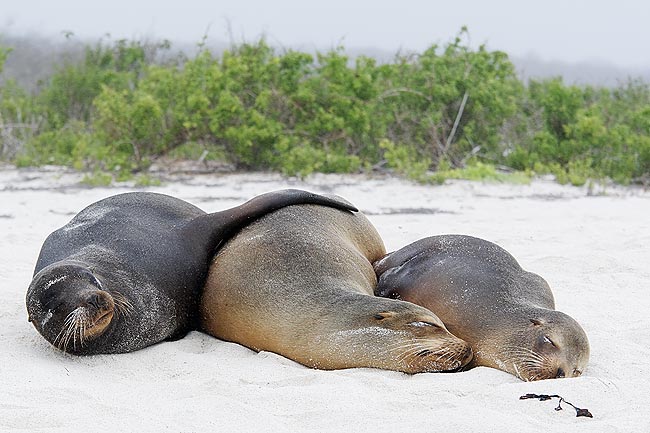
Galapagos Sea Lions, Gardener Bay, Hood Island, (Espanola), Galapagos, Ecuador
Image Copyright 2007: Arthur Morris/BIRDS AS ART
Canon 70-200mm f/4 L IS lens with the 1.4X II TC (handheld at 135mm) with the EOS-1D Mark III. ISO 400. Evaluative metering +1 stop: 1/250 sec. at f/10.
Here I used the central sensor only with One-Shot AF, focused on the eye of the sea lion in the middle, and re-composed.
IPT UPDATES
Bosque #1: "The Fall Color IPT" NOV 13-15, 2007. Slide Program on the evening of NOV 12. 3-DAY: $999. (Limit 14; openings: 1). Co-leader: Robert O'Toole. Guest leader (DAY 3 only): Andy Rouse. This IPT should feature a better chance for a day or two of the rare south winds that drastically improve flight photography and will definitely feature the brightest fall-color cottonwoods.
Bosque #2: "The Pre-Thanksgiving IPT" NOV 18-20, 2007. Slide Program on the evening of NOV 17. 3-DAY: $999. (Limit 14; Sold Out). Co-leader: Robert O'Toole, Robert Amoruso, & Alfred Forns. Guest leader: Andy Rouse. This IPT will feature increasing numbers of geese and cranes with lots of great opportunities. In 2007, I will again be hosting a Thanksgiving Day luncheon at Las Lunas Mansion, a fine restaurant in an historic building. You will need to reserve a spot and pay in advance. Details TBA; strictly limited to 50 folks.
Bosque #3: "The Post-Thanksgiving IPT" NOV 24-26, 2007. Slide Program on the evening of NOV 23. 3-DAY: $999. (Limit 14: Sold Out) Co-leaders: Robert O'Toole, Robert Amoruso, and Alfred Forns. This IPT is scheduled on dates that I consider peak for Bosque. (There may be a Full Moon Add-on NOV 23; details TBA.) If you register for this one, hold off on buying your plane ticket if you might be interested in the add-on.) In 2007, I will again be hosting a Thanksgiving Day luncheon at Las Lunas Mansion, a fine restaurant in an historic building. You will need to reserve a spot and pay in advance. Details TBA; strictly limited to 50 folks.
BIG NEWS! SW FLA Post X-mas IPT: DEC 27-29, 2007. Slide program on the of evening Wednesday, DEC 26, 2006. 3-DAY: $1029. (Limit 12; openings: 3) Co-leaders: Alfred Forns, & Robert O'Toole. Joining us as guest co-leader will be full time professional photographer John Moran, Florida's unofficial Photographer Laureate. You can learn about John’s amazing work here: www.johnmoranphoto.com. John will be doing his program, “Journal of Light: A Photographer's Search for the Soul of Florida" for the group on Wednesday, DEC 26 at 3:30 pm. John’s work is so different from mine and from everyone else’s that he has been a huge inspiration to me over the past two years. We will be visiting Sanibel Island, Venice Rookery, Cape Coral, and possibly Little Estero Lagoon (depending on the tides). Herons, egrets, gulls, terns, skimmers, shorebirds, both pelicans, Osprey, Burrowing Owl, and lots more. Roseate Spoonbill and Wood Stork possible.
NEW: San Diego IPT: JAN 20-23, 2008. Slide program on the Saturday early evening of JAN 19. 4-DAYS: $1399. (Limit 12; openings: 8.) LaJolla, LaJolla Shores Beach, Coronado, and Santee Lakes. Brown Pelicans in spectacular breeding plumage, Heerman’s & Western Gulls, Marbled Godwits & lots more shorebirds, Wood & Ring-necked Ducks & Lesser Scaup. Great flight photography. And lots more.
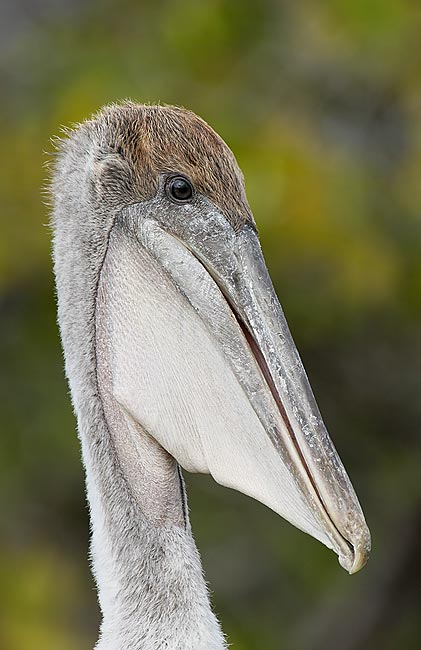
Brown Pelican, large chick, Moreno Point, Isabella I., Galapagos, Ecuador
Image Copyright 2007: Arthur Morris/BIRDS AS ART
Canon 500mm f/4L IS lens with the 2X II TC and the EOS-1D Mark III. ISO 400. Evaluative metering +1/3 stop: 1/400 sec. at f10.
To understand the tremendous magnifying power of a big lens with a 2X teleconverter, compare the image above with the one below. I was standing in the same spot and the images were made just a minute apart. The bird in this image is the third bird from the right in the image below. I
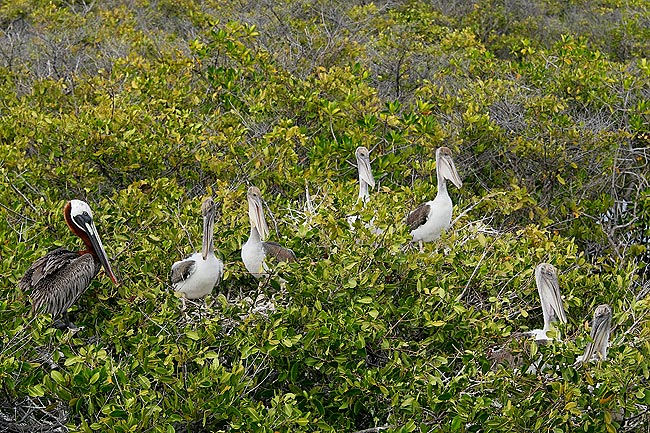
Brown Pelican, adult with six chicks, two in each nest, Moreno Point, Isabella I., Galapagos, Ecuador
Image Copyright 2007: Arthur Morris/BIRDS AS ART
Canon 70-200mm f/4 L IS lens with the 1.4X II TC (handheld at 98mm) with the EOS-1D Mark III. ISO 400. Evaluative metering +1/3 stop: 1/320 sec. at f/8.
Different moment, different vision, different lens... Which image do you like better?
Best and love and great picture-making to all,
artie
Note: Arthur Morris has been a Canon contract photographer since 1994 and continues in that role today. Hunt's Photo of Boston, MA is a BAA sponsor as is Delkin Devices. Back issues of all BAA Bulletins can be found in the Bulletin Archives which may be accessed from the home page at www.birdsasart.com